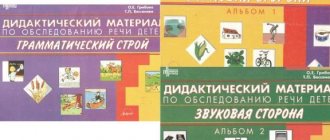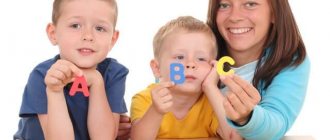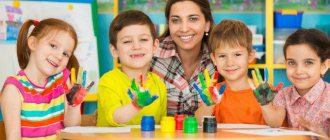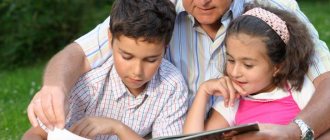Main types of joint activities between teachers and children
Time dictates change. We change, our environment changes. Modern society places new demands on the education system, including the first level – preschool education. And we need to learn how to organize the educational process in accordance with the provisions of the Federal State Educational Standard for Education.
One of the principles of the Federal State Educational Standard for Educational Education is the principle of assistance and cooperation between children and adults, recognition of the child as a full participant in educational relations.
The educational process includes 2 main components:
Joint partnership between an adult and children,
Free independent activity of the children themselves.
Lev Semenovich Vygotsky noted that the joint partner activity of an adult with children involves the child’s double motivation: on the one hand, the desire to be with the adult, to imitate him, to cooperate with him, and on the other hand, to do what is interesting. Partnership is, first of all, the equal inclusion of an adult in the process of activity.
Cooperative activity
– the basic model for organizing the educational process of preschool children. This is the activity of two or more participants in the educational process (adults and students) to solve educational problems in the same space and at the same time.
As part of the joint activities of an adult and children, problems
broad plan:
- development of general cognitive abilities (including sensory, symbolic thinking)
- development of children's initiative in all areas of activity;
- development of the ability to plan one’s own activities and voluntary effort aimed at achieving results, the task of the child mastering the “world order” in its natural and man-made aspects (building a coherent picture of the world).
Joint activities include:
- individual,
- subgroup,
- a group form of work with children and is carried out both in the form of educational activities and in the form of educational activities carried out during regime moments.
At the same time, the joint activity of an adult and a child is not only a stage in the development of any type of activity, but also a special system of relationships and interaction.
Joint activity between an adult and a child is, first of all, an activity during which emotional contact and business cooperation are established. It is very important to organize joint actions so that the teacher can call the child for verbal interaction or find lively, accessible reasons for the child to communicate. Organization and planning of joint activities must be flexible. The teacher must be ready for improvisation and for the child’s counter-activity. In the process of joint activity, the child gradually develops the position of a junior partner, guided by an adult and constantly taking into account the latter’s initiative. The joint activity of the teacher and children is based on the desire, characteristic of children, to participate in the real, “real” affairs of an adult.
The main areas of joint activity between teachers and children can be the following:
- project activities
- cognitive-game activity
- work activity
- associations of children by interests
- club activities
Depending on the type of joint activity between the teacher and children, there are various methods of interaction with them. The most common types of joint activities:
- Interaction in gaming activities
- Interaction in organizing problem-search (project) activities
- Features of interaction taking into account a gender approach.
1. The most effective in working with children are indirect influences, primarily influences through play and playful communication.
By entering into playful communication, the teacher gets the opportunity, in an economical way, to manage the activities of children, their development, regulate relationships, and resolve conflicts.
When joining the game, the teacher tactfully and carefully guides the players, taking care not to destroy their plan. At the same time, he solves various management tasks, which were identified taking into account the peculiarities of the game’s development. In order for children to realize a variety of ideas in games, the teacher must pay great attention to developing in them ways to realize their plans. Most children have well-developed objective ways of displaying their surroundings in a game, so the teacher only encourages them for their interesting invention in choosing an objective way to solve game problems. By forming role-playing methods, the teacher changes the forms of activating communication, he talks more with the players, encouraging them to role-playing statements and conversation, for this purpose he asks children questions about the content of the game. In gaming activities
children should be seen to be consistent and systematic, otherwise building a dialogue with children will be difficult and even problematic. For a teacher, play is a time to observe children, their actions, words, and interactions with peers. He must analyze the children’s play plans and see their experiences. Only in this case will he be able to correctly adjust the game and not disrupt its flow, which means he will interact organically with children. The teacher should come to play sessions with several games prepared in order to let them think about the theme of the game and let the children make their own choices. Skillfully help you stop at the most interesting. This develops their initiative. The teacher must recognize in time the children’s loss of interest in the game and support it with his actions. You can use new characters, change the tactics of the game, and give the children the opportunity to propose a continuation of the game based on their plot. And sometimes the teacher can become a full-fledged participant in the game, this really “turns on” the preschool children and makes the relationship between them closer. The skillful guidance of the teacher will make him a welcome participant in any games, and the game process itself will bring full fruit in the development of the preschooler.
2.
A preschooler cannot yet find answers to all his questions on his own; teachers help him.
Along with the explanatory and illustrative teaching method, teachers use problem-based learning methods
: questions that develop logical thinking, modeling problem situations, experimentation, experimental research, solving crosswords, charades, and puzzles.
Problem-based learning is characterized, first of all, by an independent search for solutions to various problems, promotes the meaningful assimilation of knowledge, the development of creative skills, independence, and activity. The child’s need for this method arises when it is impossible to solve the problem using known methods. In this regard, when developing the content of developmental education, especially close attention requires the selection of not only the knowledge that children must learn in the process of independent search activity, but also that which is intended for direct transmission. Joint activities, in this case, must be organized in such a way that the child’s special activity appears, so that children can argue, prove the truth, and communicate freely with each other. A person who is not accustomed from childhood to think independently, who assimilates everything in a ready-made form, will not be able to demonstrate the inclinations given to him by nature. In order for learning to contribute to the development of a preschooler’s thinking, it is necessary to use methods that will give the child the opportunity to comprehend the educational material. Reliance on a question that is significant for the child is necessary when a preschooler is faced with a contradictory choice, sometimes makes a mistake, and then corrects it independently. The problem-search method is especially prominent in pedagogy at present.
.
Organizing discussions stimulates the search for the right solution. The need to explain a friend’s methods of action involves all children in the process of solving the problem (even in cases where the child practically does not act). The creation of problematic situations, the constant cooperation of children with teachers allows you not to worry about maintaining discipline, there is no need to ensure that children are not distracted. With such an organization, no additional means are required to attract attention. At the same time, business cooperation arises within the children's team. Children are actively involved in the search situation, and in the process of solving a game or practical problem, they help each other. In addition, knowledge should involve children in solving problem-search tasks formulated on the basis of personal experience; activate cognitive interests, the desire to assimilate new information; stimulate mental activity (processes of analysis, synthesis, comparison, generalization and classification); increase levels of self-control, self-organization and self-esteem.
In order for activity not to weaken, along with clear, distinct knowledge, there must remain a zone of uncertainty. Let children independently look for solutions to the problems assigned to them, try, experiment, make mistakes and receive an unexpected answer to their questions. Satisfaction of curiosity should be combined with impatience to find out what will happen in the next lesson, with an attempt to express your hypotheses and assumptions. This problem-based learning strategy is built on the “principle of developing intrigue...”
The art of a teacher lies in the ability to correctly evaluate both correct and incorrect decisions, directing the search activity of children. The teacher should pay special attention to incorrect answers. By analyzing the solution path and the conclusion that was made with the children, the adult helps them understand their mistake and leads them to find a new way. First of all, the child’s cognitive activity should be encouraged. The organization of direct educational activities should help the child turn from a passive, inactive observer into an active participant.
3.
In preschool age, there is an intensive process of developing a child’s self-awareness, an important component of which is awareness of oneself as a representative of a certain gender.
The problem of gender socialization, which includes issues of the formation of the child’s mental gender, mental sexual differences and gender role differentiation, is one of the most important and pressing problems in education.
Gender education
- this is the formation in children of ideas about real men and women necessary for the normal and effective socialization of the individual. Under the influence of adults, a preschooler must learn the gender role, or gender model of behavior that a person adheres to in order to be defined as a woman or a man. By the age of 2-3 years, children begin to understand that they are either a girl or a boy, and identify themselves accordingly. At the age of 4 to 7 years, gender stability is formed: children understand that gender does not change: boys become men, and girls become women, and this gender will not change depending on the situation or personal desires of the child. Girls of preschool age are “more social” and more suggestible than boys; they cope better with simple, routine tasks, while boys are better at more complex cognitive processes. Girls are more influenced by heredity, while boys are more influenced by environment. Girls have more developed auditory perception, and boys have more developed visual perception and much more. The most favorable age period for starting gender education is the fourth year of life. Already in the fourth year of life, children whose behavior corresponds to correct gender education feel different from the opposite sex.
The role of kindergarten in gender education is very important, but still, it is obvious that raising children taking into account their gender characteristics will largely be determined by the individual characteristics of each child and depend on those patterns of behavior of women and men that the child constantly encounters in the family. In this regard, the primary task is to train educators to implement a differentiated approach to girls and boys, both when communicating with them and when organizing and leading various activities in the classroom and in everyday life. When teaching children, it is important for the teacher to take into account that girls need stimuli that are more based on auditory perception. Boys do not readily perceive the teacher’s explanation by ear and it is preferable for them to use visual means based on visual perception. When raising boys and girls together, a very important pedagogical task is to overcome the disunity between them and organize joint games, during which children could act together, but in accordance with gender characteristics. Boys take on masculine roles, and girls take on feminine roles. Theatrical activities can be structured in a similar way.
The successful formation of a child’s personality, his mental and personal developments occur only in the process of communication and joint activities with an adult. In these two spheres of life, the child’s intellectual and personal development, his orientation in the objective world and in the system of human relations are carried out. In the process of interaction with an adult, the child’s basic communication needs, which form the basis of a person’s personality, are satisfied. It is important that there is mutual respect .
Respect is a necessary element in the community that the kindergarten group is. Educators set the example of mutual understanding, respect and care for each other that they expect from children. The amount of respect children feel from others is a key factor in their development of self-esteem. And self-esteem, in turn, lays a strong foundation for positive relationships with other children. When teachers show respect for each child in the group, children learn to accept all other children - those who run slowly, those who draw well, and even children with unusual or conflicting behavior. When children see and feel that each of them is accepted and respected, they begin to feel comfortable and can behave freely and pursue their own interests.
Educators should realize that children, like adults, feel and notice the sincerity with which they are treated. Children should be praised for their work individually and sincerely, and interaction should be natural and relaxed.
Children embrace and respond to age-appropriate humor and fun. Adults should not be afraid that by laughing and joking with children they may lose control of order in the group. On the contrary, general fun only brings teachers closer to children, and the atmosphere of cooperation in the group is strengthened.
There is no upbringing without difficulties and problems. A teacher is first and foremost a person. With your feelings and needs. And education is a living process of human relations. Good parenting cannot take place without constant work on these relationships and without constant work on oneself. We love flowers, but without knowing the specifics of caring for them and without creating the necessary conditions for their growth, we are unlikely to wait for them to bloom.
Thus, modern approaches to organizing the educational process define the partnership position and partnership activities of the teacher with children as the basis for joint activities in a preschool institution, as a necessary requirement for the implementation of the Federal State Educational Standard for preschool education.
Municipal autonomous preschool educational
institution kindergarten No. 5 “Spikelet” of a combined type
village of Ermolaevo municipal district Kuyurgazinsky district
Republic of Bashkortostan
Main types of joint activities between teachers and children
Teacher of the highest category:
Sorokina N.A.
Ermolaevo village, 2020
Planning joint activities
When planning joint activities, its structure must be determined. For example, in the case of children of senior preschool age, its structure will be as follows:
- formulation by the teacher of the task and acceptance of it by each participant in the activity;
- analysis of the problem, children put forward and choose ways to solve the problem;
- discussion and evaluation of the obtained result of joint activities.
Joint activity consists of play, problem, cognitive and other situations or tasks. Joint activities are planned and monitored in the following format:
- targeted walks;
- observations;
- examinations;
- experimentation;
- creative activity.
Today, it is important to implement joint activities of children, teachers and parents through a variety of projects, in which parents should take an active part, as in educational activities, and not just act as outside observers.
In other words, the joint activity of a teacher and children is a promising form of developmental education. Educational situations in the joint interaction of a teacher and children are transformed and become situations of co-development and co-realization of an adult and children in the educational space of a preschool educational institution.






